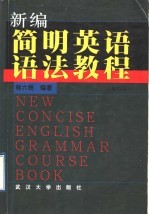图书介绍
新编简明英语语法教程 修订版pdf电子书版本下载

- 林六辰编著 著
- 出版社: 武汉:武汉大学出版社
- ISBN:7307032112
- 出版时间:1999
- 标注页数:418页
- 文件大小:8MB
- 文件页数:434页
- 主题词:英语(学科: 语法) 英语 语法
PDF下载
下载说明
新编简明英语语法教程 修订版PDF格式电子书版下载
下载的文件为RAR压缩包。需要使用解压软件进行解压得到PDF格式图书。建议使用BT下载工具Free Download Manager进行下载,简称FDM(免费,没有广告,支持多平台)。本站资源全部打包为BT种子。所以需要使用专业的BT下载软件进行下载。如 BitComet qBittorrent uTorrent等BT下载工具。迅雷目前由于本站不是热门资源。不推荐使用!后期资源热门了。安装了迅雷也可以迅雷进行下载!
(文件页数 要大于 标注页数,上中下等多册电子书除外)
注意:本站所有压缩包均有解压码: 点击下载压缩包解压工具
图书目录
导论(Introduction) 1
0.1什么是语法?(Whatisgrammar?) 1
0.2英语语法的结构层次(ThehierarchyofEnglishgrammar) 2
第一讲 句子结构(Sentencestructure) 7
1.1主语和谓语(Subject predicate) 7
1.2基本句型和词类(Basicclausetypes partsofspeech) 9
1.3基本句型的转换与扩展(Transformation expan-sionofbasicclausetypes) 10
第二讲 名词(Nouns)1 14
2.1名词的种类(Classificationofnouns) 14
2.2名词的数(Number) 15
第三讲 名词(Nouns)2 22
3.1名词的性(Gender) 22
3.2名词的格(Case) 23
第四讲 冠词(Articles) 29
4.1冠词的语义及用法(Systemsofarticleusage) 29
4.2定冠词的类指惯用法(Idiomaticusageofdefinitearticlewithgenericreference) 30
4.3普通名词的零冠词用法(Commonnounswithzeroarticle) 32
第五讲 代词(Pronouns)1 39
5.1代词分类(Subclassesofpronouns) 39
5.2中心代词(Centralpronouns) 40
5.3指示代词(Demonstrativepronouns) 42
第六讲 代词(Pronouns)2 47
6.1整体代词(Universalpronouns) 47
6.2部分代词(Partitivepronouns) 49
6.3数量代词(Quantifyingpronouns) 51
第七讲 限定词(Determiners) 58
7.1所指限定词和数量限定词(Identifiers quantifiers) 58
7.2限定词与名词的搭配(Cooccurrenceofdeterminerswithnouns) 59
第八讲 动词(Verbs) 67
8.1动词的分类(Typesofverb) 67
8.2动词的限定形式和非限定形式(Finiteandnon-finiteverbphrase) 68
8.3规则动词与不规则动词(Regularverb irregularverb) 69
8.4动词的静态意义和动态意义(Stativeverb dy-namicverb) 71
第九讲 动词的时(Tense) 77
9.1一般现在时(Thesimplepresenttense) 77
9.2一般过去时(Thesimplepasttense) 79
第十讲 动词的体(Aspect)1 85
10.1动词的体(Aspect) 85
10.2现在完成体(Thepresentperfective) 86
10.3过去完成体(Thepastperfective) 87
第十一讲 动词的体(Aspect)2 93
11.1进行体(Theprogressiveaspect) 93
11.2完成进行体(Theperfectprogressive) 94
第十二讲 将来表达法(Thefuture) 101
12.1“Will/shall+动词”(Will/shall+V.) 101
12.2“Begoingto+动词”(Begoingtodosth.) 102
12.3现在进行体(Thepresentprogressive) 102
12.4一般现在时(Thesimplepresenttense) 103
12.5“Will/shall+进行体”(Will/shall+progressive) 103
12.6“Be+不定式”(Betodosth.) 104
12.7“Beabout+不定式”(Beabouttodosth.) 104
13.2被动态的应用(Usesofthepassive) 111
13.1主动态与被动态之间的对应关系(Theactive-passivecorrespondence) 111
第十三讲 被动态(Passivevoice) 111
13.3Get-被动态(Get-passive) 113
13.4主动态与被动态转换的一些限制(Voiceconstraints) 114
第十四讲 虚拟式(Subjunctivemood) 121
14.1Be-型虚拟式(Be-subjunctive) 121
14.2Were-型虚拟式(Were-subjunctive) 123
14.3虚拟式的否定构成(Thenegativeformofsub-junctivemood) 123
第十五讲 情态动词(Modalauxiliaries) 127
15.1情态动词(Can,could,may,might) 127
15.2情态动词(Shall,will,would) 128
15.3情态动词(Should,oughtto,must,haveto) 130
15.4情态动词与体(Themodals aspect) 131
15.5情态动词(Need,dare) 132
15.6情态动词(Usedto) 133
15.7情态习语(Modalidioms) 134
第十六讲 不定式(Infinitive) 140
16.1否定不定式(Negativeinfinitive) 140
16.2分裂不定式(Splitinfinitive) 140
16.3省略不定式(Ellipticalinfinitive) 141
16.4不定式与形容词搭配(Usedasadjectivecomple-ment) 143
16.5不定式与名词搭配(Usedaspost-modifierofnoun) 144
16.6不定式与动词搭配(Usedasobjectorobjectcomplement) 145
第十七讲 -ing分词(-ingparticiple) 151
17.1-ing分词的句法作用及否定构成(Thesyntacticfunctionof-ingparticipleanditsnegativeform) 151
17.2-ing分词前置修饰名词时与名词的句法关系(Thesyntacticrelationbetweenthe-ingparticipleandthenounitpre-modifies) 152
17.3-ing分词与动词的搭配(Usedastheobjectofverb) 152
第十八讲 -ed分词(-edparticiple) 159
18.1-ed分词的构成及意义(Theformof-edpartici-pleanditsmeaning) 159
18.2-ed分词的句法作用(Thesyntacticfunctionof-edparticiple) 159
第十九讲 形容词(Adjectives) 167
19.1形容词的分类(Theclassificationofadjectives) 167
19.3形容词的句法作用(Syntacticfunctionsofadjectives) 169
19.2形容词与分词(Adjectives participles) 169
第二十讲 副词(Adverbs) 177
20.1副词的构成及意义(Theformationofadverbsandtheirmeanings) 177
20.2副词的句法作用(Syntacticfunctionsofadverbs) 178
第二十一讲 比较等级和比较结构(Comparison compara-tiveconstruction) 185
21.1形容词和副词的比较等级(Comparisonofadjec-tives adverbs) 185
21.2比较结构(Comparativeconstructions) 186
21.3其他比较结构及对比(Othercomparativeconstruc-tionsandtheircontrast) 191
第二十二讲 介词词组(Prepositionalphrases) 196
22.1简单介词与复杂介词(Simple complexprepositions) 196
22.2介词与形容词、动词、名词的搭配(Collocationofprepositionswithadjectives,verbs nouns) 197
22.3介词词组的句法作用(Syntacticfunctionsofprepositionalphrases) 199
第二十三讲 主谓一致(Subject-predicateconcord) 206
23.1名词词组作主语(NounPhrasesassubject) 206
23.2含有并列结构的主语(Subjectwithcoordination) 209
23.3分句作主语(Clausesassubject) 211
23.4不符合意义一致原则的特殊情况(Fewexceptions) 212
第二十四讲 简单句(Simplesentence)1 217
24.1陈述句(Statements) 217
24.2疑问句(Questions) 219
25.1祈使句(Commands) 228
第二十五讲 简单句(Simplesentence)2 228
25.2感叹句(Exclamations) 230
25.3惯用语(Formulae) 231
第二十六讲 并列结构(Coordinateconstruction) 234
26.1并列结构的形式(Coordinationatdifferentlevels) 234
26.2并列连词的意义及用法(Themeaningsofcoor-dinatorsandtheirusage) 235
26.3并列结构中的标点符号(Punctuationwithincoordinatedstructures) 237
第二十七讲 从属结构(Subordinateconstruction) 243
27.1从属分句的构成形式(Formsofthesubordinateclause) 244
27.2从属连词(Subordinators) 244
27.3从属分句的句法作用(Syntacticfunctionsofthesubordinateclause) 246
第二十八讲 名词性分句(Nominalclauses) 250
28.1名词性that-分句(Nominalthat-clause) 250
28.2名词性疑问分句(Nominalinterrogativeclauses) 251
28.3名词性关系分句(Nominalrelativeclause) 252
第二十九讲 关系分句(Relativeclauses) 261
29.1限制性关系分句(Restrictiverelativeclause) 261
29.2非限制性关系分句(Non-restrictiverelativeclause) 263
29.3句际关系分句(Sententialrelativeclause) 263
29.4双重关系分句和嵌入式关系分句(Doublerelativeclause embeddedrelativeclause) 264
29.5关系分句与同位语分句(Relativeclausevs.appositiveclause) 265
30.1时间状语分句(Adverbialclauseoftime) 272
第三十讲 状语分句(Adverbialclauses) 272
30.3方式状语分句(Adverbialclauseofmanner) 273
30.2地点状语分句(Adverbialclauseofplace) 273
30.4原因状语分句(Adverbialclauseofcause) 274
30.5目的状语分句(Adverbialclauseofpurpose) 274
30.6结果状语分句(Adverbialclauseofresult) 275
30.7让步状语分句(Adverbialclauseofconcession) 275
第三十一讲 条件句(Conditionalsentence) 282
31.1真实条件句(Realconditional) 282
31.2虚拟条件句(Unrealconditional) 284
32.1不定式分句(Theinfinitiveclause) 290
第三十二讲 非限定分句和无动词分句(Nonfiniteclauses verblessclause) 290
32.2-ing分词分句(The-ingparticipleclause) 292
32.3-ed分词分句(The-edparticipleclause) 295
32.4无动词分句(Theverblessclause) 297
第三十三讲 直接引语和间接引语(Direct indirectspeech) 303
33.1陈述句的间接引语(Indirectstatements) 303
33.2疑问句、感叹句和祈使句的间接引语(Indirectquestions,commands exclamations) 305
33.3间接引语中的情态动词(Themodalauxiliaries indirectspeech) 306
34.1英语句子的特点(FeaturesofEnglishsentence) 312
34.2There-句型(Existentialsentence) 312
第三十四讲 There-句型(Existentialsentence) 312
34.3形式主语there(Existentialthereassubject) 314
34.4There-句中的关系分句(Relativeclauseinexis-tentialsentence) 314
34.5非be动词there-句型(Existentialsentencewithverbsotherthanbe) 315
第三十五讲 It-句型(It-patterns) 318
35.1虚义it(Propit) 318
35.2先行it(Anticipatoryit) 319
35.3裂式强调it(Itasintroductorywordofcleftsentence) 319
35.4拟似分裂句(Pseudo-cleftsentence) 321
36.1前置(Fronting) 325
第三十六讲 前置与倒装(Fronting inversion) 325
36.2倒装(Inversion) 326
第三十七讲 替代与省略(Substitution ellipsis) 333
37.1替代(Substitution) 333
37.2省略(Ellipsis) 336
第三十八讲 从句到篇(Fromsentencetotext) 343
38.1句子和语篇(Sentence text) 343
38.2语篇纽带(Textualconnectors) 344
练习参考答案 352
语法术语缩略语及符号说明 416
参考书目 418